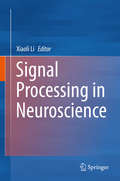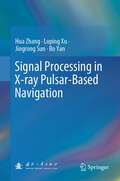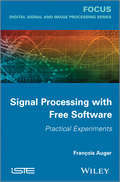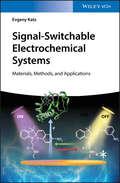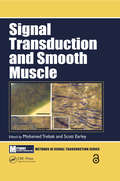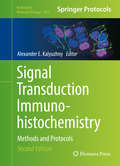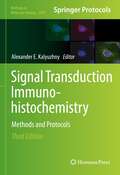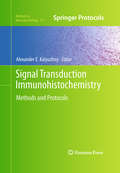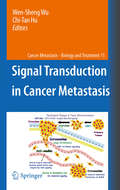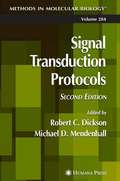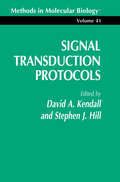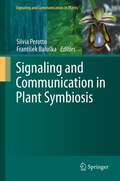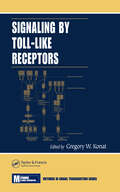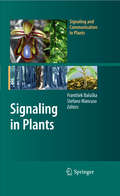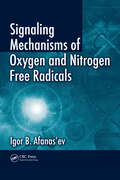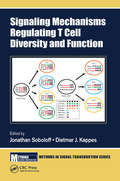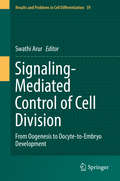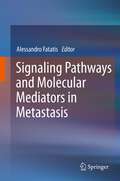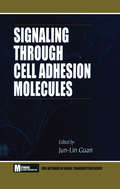- Table View
- List View
Signal Processing in Neuroscience
by Xiaoli LiThis book reviews cutting-edge developments in neural signalling processing (NSP), systematically introducing readers to various models and methods in the context of NSP. Neuronal Signal Processing is a comparatively new field in computer sciences and neuroscience, and is rapidly establishing itself as an important tool, one that offers an ideal opportunity to forge stronger links between experimentalists and computer scientists. This new signal-processing tool can be used in conjunction with existing computational tools to analyse neural activity, which is monitored through different sensors such as spike trains, local filed potentials and EEG. The analysis of neural activity can yield vital insights into the function of the brain. This book highlights the contribution of signal processing in the area of computational neuroscience by providing a forum for researchers in this field to share their experiences to date.
Signal Processing in X-ray Pulsar-Based Navigation
by Hua Zhang Luping Xu Jingrong Sun Bo YanThis book highlights key technologies of signal processing in pulsar-based navigation. It discusses the modeling, simulation, acquisition, and correction of relativistic effects of signals from X-ray pulsars. It demonstrates the methods of contour reconstruction and denoising, and introduces the concept and methods of the average contour. The performance of the phase measurement methods using signal contour is analyzed. The role of wavelets and bispectral methods in the denoising of pulsar signals is discussed. The measurements of pulsar signals’ arriving time are looked into from the perspective of time series. The book is intended for researchers and engineers interested in pulsar-based navigation. It is also a good reference source for senior undergraduates and postgraduate students majoring in navigation and signal processing.
Signal Processing with Free Software: Practical Experiments
by François AugerAn ideal resource for students, industrial engineers, and researchers, Signal Processing with Free Software Practical Experiments presents practical experiments in signal processing using free software. The text introduces elementary signals through elementary waveform, signal storage files and elementary operations on signals and then presents the first tools to signal analysis such as temporal and frequency characteristics leading to Time-frequency analysis. Non-parametric spectral analysis is also discussed as well as signal processing through sampling, resampling, quantification, and analog and digital filtering. Table of Contents: 1. Generation of Elementary Signals. Generation of Elementary Waveform. – Elementary Operations on the Signals. – Format of Signal Storage Files. 2. First tools of Signal Analysis. Measurement of Temporal and Frequency Characteristics of a Signal. Time-Frequency Analysis of a Signal. 3. Non-parametric Spectral Analysis. 4. Signal Processing. Sampling. – Resampling. – Quantification. – “Analog” Filtering. Digital Filtering
Signal-Switchable Electrochemical Systems: Materials, Methods, and Applications
by Evgeny KatzA guide to the biological control over electronic systems that lead the way to wearable electronics and improved drug delivery In recent years, this area of electrochemical systems has developed rapidly and achieved significant progress. Signal-Switchable Electrochemical Systems offers an overview to the wide-variety of switchable electrochemical systems and modified electrodes. The author—a noted researcher and expert on the topic—summarizes research efforts of many groups in a range of universities and countries. The book explores various types of external signals that are able to modify electrode interfaces, for example electrical potential, magnetic field, light, as well as chemical and biochemical inputs. Multifunctional properties of the modified interfaces allow their responses to complex combinations of external signals. These are integrated with unconventional biomolecular computing systems logically processing multiple biochemical signals. This approach allows the biological control over electronic systems. The text explores the applications in different areas, including unconventional computing, biofuel cells and signal-triggered molecular release in electrochemical systems. This important guide: Provides an overview to the biological control over electronic systems and examines the key applications in biomedicine, electrochemical energy conversion and signal-processing Offers an important text written by a highly cited researcher and pioneer in the field Contains a summary of research efforts of an international panel of scholars representing various universities and countries Presents a groundbreaking book that provides an introduction to this interdisciplinary field Written for scientists working with electrochemical systems and applications with signal-responsive materials, Signal-Switchable Electrochemical Systems presents an overview of the multidisciplinary field of adaptable signal-controlled electrochemical systems and processes and highlights their key aspects and future perspectives.
Signal Transduction: Pathways, Mechanisms and Diseases
by Ari SitaramayyaThe book was adapted from graduate courses on signal transduction taught by the editor, where the need for a good overview of recent developments became apparent. Given the wide range of research topics in signaling, a selection was made that not only reflects the current research interest, but also anticipates those areas that will continue to be of interest over the next several years. The health-relatedness of research was a major criterion for selection, as can be seen in the list of topics covered, such as G protein coupled receptors, growth factors, nuclear receptors, reactive oxygen and nitrogen species, the cell cycle and cancer. The emphasis is on areas of signaling research with direct clinical significance. Another field covered, one rarely highlighted in signal transduction books, is that of signaling platforms, which has been emerging as a significant research area relevant to cellular metabolism, cell proliferation, differentiation, apoptosis, neurodegenerative diseases, and cancer.
Signal Transduction and Smooth Muscle (Methods in Signal Transduction Series)
by Mohamed Trebak and Scott EarleyAll hollow organs, such as blood vessels, the gastrointestinal tract, airways, male and female reproductive systems, and the urinary bladder are primarily composed of smooth muscle. Such organs regulate flow, propulsion and mixing of luminal contents and storage by the contraction and relaxation of smooth muscle cells. Smooth muscle cells respond to numerous inputs, including pressure, shear stress, intrinsic and extrinsic innervation, hormones and other circulating molecules, as well as autocrine and paracrine factors. This book is a review of smooth muscle cell regulation in the cardiovascular, reproductive, GI, and other organ systems with emphasis on calcium and receptor signaling. Key selling features: Focuses on smooth muscles of different types Describes ion channel signaling mechanisms Reviews calcium and receptor signaling Includes novel, cutting-edge methodologies Summarizes studies of mice with genetically encoding sensors in smooth muscle Chapter 9 of this book is freely available as a downloadable Open Access PDF at http://www.taylorfrancis.com under a Creative Commons Attribution (CC-BY) 4.0 license.
Signal Transduction Immunohistochemistry
by Alexander E. KalyuzhnyUnlike detecting constitutively expressed targets, immunohistochemical detection of labile, low abundance, and short-lived signal transduction molecules can be a very difficult task. In Signal Transduction Immunohistochemistry: Methods and Protocols, IHC experts contribute detailed protocols addressing the numerous challenges of signal-transduction immunohistochemistry (ST-IHC). Beginning with a set of introductory chapters, the volume moves on to cover techniques used for the preservation of antigens and their unmasking, protocols in digital imaging and image analysis of stained cells and tissues, high-throughput data collection and data analysis, and techniques used in neuroscience as well as cancer and stem cell research. Written in the highly successful Methods in Molecular Biology(tm) series format, chapters include brief introductions to their respective topics, lists of the necessary materials and reagents, step-by-step, readily reproducible laboratory protocols, and tips on troubleshooting and avoiding known pitfalls. Authoritative and practical, Signal Transduction Immunohistochemistry: Methods and Protocols serves as an ideal guide for novices and as a bastion of inspiring ideas to be exploited by experienced researchers on the lookout for new experimental tricks and hints.
Signal Transduction Immunohistochemistry: Methods and Protocols (Methods in Molecular Biology #2593)
by Alexander E. KalyuzhnyThis new edition collects diverse protocols compiled by experts from different areas of research as well as by biotech researchers developing novel technologies in the area of immunohistochemistry (IHC). After a few chapters to help orient novices entering the biomedical arena, the book includes methods chapters covering multiplex IHC including fluorescence and chromogenic techniques, combination of IHC with In Situ Hybridization (ISH), wavelet transform approach for organelle tracking, transcription factors in human stem cells, differentiation of mesenchymal stem cells, 3D imaging, phenotyping of glial cells in the human brain, tissue fixation, permeabilization, and cryo-preservation, as well as other topics. Written for the highly successful Methods in Molecular Biology series, chapters include introductions to their respective topics, lists of the necessary materials and reagents, step-by-step and readily reproducible laboratory protocols, and tips on troubleshooting and avoiding known pitfalls. Authoritative and up-to-date, Signal Transduction Immunohistochemistry: Methods and Protocols, Third Edition aims to arm novices and experts with vital protocols they can use either as-is or tailor them for specific experimental needs.
Signal Transduction Immunohistochemistry
by Alexander E. KalyuzhnyUnlike detecting constitutively expressed targets, immunohistochemical detection of labile, low abundance, and short-lived signal transduction molecules can be a very difficult task. In Signal Transduction Immunohistochemistry: Methods and Protocols, IHC experts contribute detailed protocols addressing the numerous challenges of signal-transduction immunohistochemistry (ST-IHC). Beginning with a set of introductory chapters, the volume moves on to cover techniques used for the preservation of antigens and their unmasking, protocols in digital imaging and image analysis of stained cells and tissues, high-throughput data collection and data analysis, and techniques used in neuroscience as well as cancer and stem cell research. Written in the highly successful Methods in Molecular BiologyTM series format, chapters include brief introductions to their respective topics, lists of the necessary materials and reagents, step-by-step, readily reproducible laboratory protocols, and tips on troubleshooting and avoiding known pitfalls. Authoritative and practical, Signal Transduction Immunohistochemistry: Methods and Protocols serves as an ideal guide for novices and as a bastion of inspiring ideas to be exploited by experienced researchers on the lookout for new experimental tricks and hints.
Signal Transduction in Cancer Metastasis
by Wen-Sheng Wu Chi-Tan HuThe poor prognosis and high mortality for cancer patients are majorly ascribed to tumor metastasis, one of the most complicated pathological processes. Elucidation of molecular mechanisms for metastasis is essential for management and prevention of this lethal condition. In the book to be published, we take comprehensive review in regard with the signal mechanisms responsible for triggering a series of phenotypical changes of primary tumor which may lead to final colonization of the tumor in a second home. Specifically, the initial stage of tumor metastasis will be highlighted. The complex tumor microenvironment accumulate a lot of growth factors, inflammatory cytokines and extracellular matrix which may turn into a group of potent metastatic factors. An integrated and sustained signaling induced by these metastatic factors may trigger EMT, migration and invasion of primary tumor into surround tissue. Blokcade of these signal pathways is the most effective approach for prevention of
Signal Transduction in the Retina (Methods in Signal Transduction Series)
by Steven J. Fliesler Oleg G. KisselevIn the twenty-first century, we are just beginning to understand more clearly the enormous diversity and complexity of signaling processes in the retina. Integrating advances in the biochemistry, cell biology, physiology, and physics of phototransduction, Signal Transduction in the Retina presents the methodologies and experimental approache
Signal Transduction Protocols
by Robert C. Dickson Michael D. MendenhallCarrying on the high standards of the much-acclaimed first edition, highly experienced investigators have extensively updated the first edition with many of the new approaches that have been transforming the field. Included in this new edition are readily reproducible immunoassays, fluorescence-based assays, high-throughput methods, protein modification assays, lipid second messenger assays, and chromatin immunoprecipitation techniques. Wherever possible, protocols for the assay of general classes of signal transduction components have been identified so they can be adapted to the assay of any member of that class.
Signal Transduction Protocols
by Stephen J. Hill David A. KendallThis collection of self-contained, "hands-on" descriptions of established laboratory protocols concentrates on receptor-mediated cell signaling, with particular attention devoted to those receptors that are part of the G-protein-linked superfamily. It offers those already working in the field as well as those in related areas the opportunity to expand their range of experimental techniques and to carry out successful investigations without needing to refer to any other methodological source.
Signal Transduction Protocols
by Louis M. Luttrell Stephen S. FergusonIt is increasingly clear that signal transduction is a highly organized and integrated process. Divided into two convenient sections, Signal Transduction Protocols, Third Edition focuses on experimental approaches to better understand the complexity of signal transduction. Introductory chapters provide perspective on several of the challenges involved in signal transduction research and offer guidance on selecting the best approaches to various types of questions. The individual chapters provide detailed experimental protocols covering various topics, from the effects of ligand binding on receptor conformation and effector coupling, to moving inside the cell in order to capture the spatial and temporal characteristics of signaling events. Written in the highly successful Methods in Molecular BiologyTM series format, chapters contain introductions to their respective topics, lists of the necessary materials and reagents, step-by step, readily reproducible laboratory protocols, and notes on troubleshooting and avoiding known pitfalls. Authoritative and accessible, Signal Transduction Protocols serves as an ideal guide to scientists of all backgrounds and is a valuable resource for future progress in the field of signal transduction research.
Signale aus unserer Welt!: Wohin fliegt ihr? Die Geschichte der interstellaren Radiobotschaften
by Gerhard ConradDieses Sachbuch zeichnet die geschichtliche Entwicklung der irdischen Radiobotschaften ins Universum nach: von den frühesten Spekulationen über die Existenz extraterrestrischer Intelligenz zu den ersten Radiosignalen in Richtung Venus, gefolgt von dem Bau großer Radioobservatorien, die das Senden zahlreicher intelligenter sowie irrsinniger Botschaften ins All ermöglichten. Gerhard Conrad bietet einen Blick auf die Arecibo-Nachricht, die einzige empfangene Botschaft, das Wow!-Signal, und geht auf die Sterne und Exoplaneten ein, zu denen die Nachrichten gesendet wurden. Abschließend gibt er eine Einschätzung, wie hoch die Wahrscheinlichkeit ist, dass es dort Leben oder gar hochentwickeltes Leben gibt. Dieses populärwissenschaftliche Buch richtet sich vor allem an astronomie- und weltraumbegeisterte Amateure, aber auch an professionelle Astronomen.
Signaling and Communication in Plant Symbiosis
by František Baluška Silvia PerottoA multiplicity of biotrophic micro-organisms interact with plants in nature, forming symbiotic relationships that range from mutualism to antagonism. Microorganisms that have adopted biotrophy as a lifestyle are able to colonize the plant and often to cross the plant cell boundaries by forming intracellular structures that are the site of nutrient uptake/exchange. To establish themselves within plant tissues, both mutualistic and pathogenic biotrophs need to overcome the plant defense response through an exchange of molecular signals. Our knowledge of the nature of these signals and their function in the interaction has rapidly increased over the last few years. This volume focuses on the genetic, molecular and cellular components involved in the communication between partners of well-known symbioses, but also reports on the advances for less studied systems.
Signaling by Toll-Like Receptors
by Gregory W. KonatThe discovery of toll-like receptors (TLRs) spurred the field of innate immunity into a renaissance after many years of neglect. Since then, TLR research has grown at an exponential rate. Taking an integrated methodological approach, Signaling by Toll-Like Receptors offers a comprehensive review of important techniques in molecular biology,
Signaling in Plants
by Stefano Mancuso František BaluškaThis book addresses diverse aspects of signaling at all levels of plant organization, starting from single molecules; through vesicle recycling and organelles, dynamic actin cytoskeletons, and plant organs bending in response to sensory stimuli induced by abiotic cues such as gravity and light; up to the whole organism as related to its circadian clock or pathogen defense. Emphasis is placed on the integrative aspects of signaling, which foster our understanding of sensory and communicative plants in all their complexity.
Signaling in the Heart
by José Marín-GarcíaSignal transduction pathways are at the core of most biological processes and are critical regulators of heart physiology and pathophysiology. The heart is both a transmitter and dynamic receptor of a variety of intracellular and extracellular stimuli, playing a critical role of an integrator of diverse signaling mechanisms. Alterations in signaling pathways are contributing factors in the development and progression of a broad spectrum of diseases, ranging from dysrhythmias and atherosclerosis to hypertension and the metabolic syndrome. Targeting specific components of these signaling pathways has been shown to be effective in preclinical studies with significant therapeutic impact. This book brings together current knowledge in cardiovascular cell signal transduction mechanisms, advances in novel therapeutic approaches to improve cardiac function, and discussion of future directions. Presented from a post-genomic perspective, this exciting book introduces important new ideas in cardiovascular systems biology. It is an invaluable reference for cardiology researchers and practitioners.
Signaling Mechanisms of Oxygen and Nitrogen Free Radicals
by Igor B. Afanas'evOnce the existence of free radicals was proven, an avalanche of studies on free radical-mediated biological processes ensued. The study of reactive oxygen and nitrogen species (ROS and RNS) is center stage in biological free radical investigations. Written by a biochemist, Signaling Mechanisms of Oxygen and Nitrogen Free Radicals discusses the regu
Signaling Mechanisms Regulating T Cell Diversity and Function (Methods in Signal Transduction Series)
by Jonathan Soboloff; Dietmar J. KappesT cells play a vital role mediating adaptive immunity, a specific acquired resistance to an infectious agent produced by the introduction of an antigen. There are a variety of T cell types with different functions. They are called T cells, because they are derived from the thymus gland. This volume discusses how T cells are regulated through the operation of signaling mechanisms. Topics covered include positive and negative selection, early events in T cell receptor engagement, and various T cell subsets.
Signaling-Mediated Control of Cell Division
by Swathi ArurThis volume covers the current knowledge base on the role of signaling and environmental pathways that control the normal development of germline stem cells, meiotic progression of oocytes, events of oocyte maturation and fertilization, and the birth of an embryo. Germ cells are uniquely poised to sustain life across generations through the fusion of oocyte and sperm. Because of the central importance of germ cells to life, much work has been dedicated to obtaining a clear understanding of the molecular and signaling events that control their formation and maintenance. Germ cells are set aside from somatic cells in the embryo and go through specialized meiotic cell cycles as the animal matures. These cell cycles are interspersed with long periods of arrest. In human females, meiosis I is initiated in the fetus. At birth, oocytes are arrested in meiosis I; after puberty, every month an oocyte initiates meiosis II - ovulation. Upon sperm availability these cells are fertilized, generate an embryo, and the cycle-of-life continues. During meiotic I progression and arrest, the fitness of oocytes and their progeny are likely influenced by environmental cues and signaling pathways. A lot of recent work has focused on understanding the mechanisms that regulate oocyte fitness and quality in humans and vertebrates. Much of our understanding on the events of meiosis I and germline stem cell populations comes from work in invertebrates, wherein the germline stem cells produce oocytes continuously through adult development. In both inverbrates and vertebrates nutritional and signaling pathways control the regulation of stem cells in such a manner so as to couple production of gametes with the nutritional availability. Additionally, mature oocytes arrest both in meiosis I and meiosis II, and signaling and nutritional pathways have been shown to regulate their formation, and maintenance, such that despite long periods of arrest, the oocyte quality is assured and errors in chromosome segregation and varied cytoplasmic events are minimal.
Signaling Pathways and Molecular Mediators in Metastasis
by Alessandro FatatisThis work presents the most advanced discoveries from translational research laboratories directly involved in identifying molecules and signalling pathways that play an instrumental role in metastasis. In contrast to other works, conventionally focused on a single type of tumour, the various chapters in this book provide a broad perspective of the similarities and discrepancies among the dissemination of several solid malignancies. Through recurrent and overlapping references to molecular mechanisms and mediators, the readers will gain knowledge of the common ground in metastasis from a single source. Finally, an introductory chapter provides a clinical perspective of the problems presented by metastatic tumours for diagnosis and treatment. The work presented here is directed to researchers in tumour biology with a developing interest in metastatic dissemination as well as medical and graduate students seeking to expand and integrate the notions acquired in basic cancer biology and oncology courses.
Signaling Through Cell Adhesion Molecules (Methods in Signal Transduction Series)
by Jun-Lin GuanThe field of signal transduction research is one of the fastest growing in all of biomedical research in recent years. Signaling through cell adhesion molecules have long been of interest because of their importance in embryonic development, homeostasis, immune responses, wound healing , and malignant transformation. However, it is only recently re
Signalling Pathways in Apoptosis
by Diane Watters Martin LavinApoptosis, or programmed cell death, is a necessary process by which a cell may die without adversely affecting its environment. It plays a crucial role in normal development, and in the body's defence mechanisms against disease. Too much cell death is destructive, leading to neurodegenerative diseases and impaired development. Conversely, too litt
